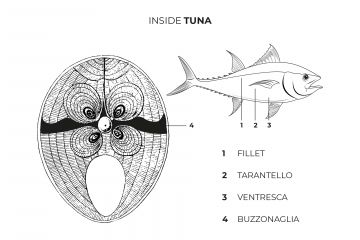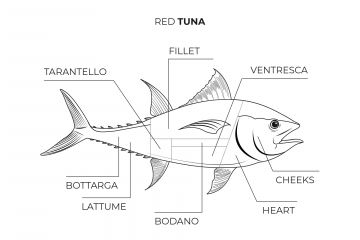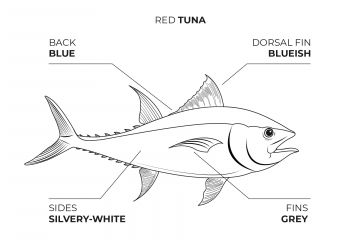Parts and types of tuna
The tuna is a saltwater fish found in the Pacific, Atlantic and Indian oceans. It lives in shoals and prefers water temperatures of at least 10°C. This fast and voracious swimmer is famous for its valuable meat and its best-known species are:
- The red tuna (Thunnus thynnus), so called because of the red colour of its flesh, is the rarest and most valued species. Widespread in Mediterranean waters, it can reach up to 600 kg in weight and 3 metres in length. Also called bluefin because of its blackish-blue colour, it is highly valued by the Japanese, who eat it raw in sashimi. In the past, we fished it using the traditional tuna trap method and processed it according to ancient traditions, but now we comply with European regulations for its fishing using modern methods and new catching equipment, such as longlines and encircling nets, and we promote restocking.
- The yellowfin tuna (Thunnus albacares) owes its name to the characteristic yellow colouration of its dorsal and ventral fins. It lives in shoals in tropical or subtropical waters and its average weight is around 40 kilograms. After processing, it better meets the demands of the Italian consumer, both in terms of taste and the appearance of the meat: tender, firm and pink. This is the only species of tuna that is canned, but it is not at risk of extinction; we mostly use specimens that weigh an average of 20 kg, guaranteeing that they are mature tuna.
- The skipjack tuna (Euthynnus pelamis) is the most widely fished and used species for fish production. Named for the longitudinal striations in the belly, this species is smaller than yellowfin tuna, averaging between 3 and 4 kg, and has lighter flesh. This species is not used by us and is often associated with FAD fishing, a method that uses fish aggregation tools and attracts small species.
- The albacore tuna (Thunnus alalunga) is the only species of tuna that has white flesh after processing; it has an average size between skipjack and yellowfin and is very popular in the UK and US markets.
- The bigeye tuna (Thunnus obesus) gets its name because it is less tapered and has a larger eye than other species. It has fatty flesh that makes it appreciated when eaten raw; the Japanese use it in sashimi, as an alternative to bluefin tuna.
Tuna is the most commonly eaten fish in our country and Italy is also the second largest European producer and distributor after Spain, with a consumption of 106,500 tonnes. Rich in protein, it is suitable for the whole family and is an important option in a diet inspired by the Mediterranean diet.
Nutritional values per 100 g of tuna
Fresh tuna
| Proteins | 21,5 g |
|---|---|
| Fats | 8,1 g |
| Carbohydrates | 0,1 g |
| Calories | 159 Kcal |
Tinned tuna
| Proteins | 25,2 g |
|---|---|
| Fats | 10,2 g |
| Carbohydrates | 0 g |
| Calories | 192 Kcal |
It is said that nothing is thrown away from tuna. Here are the various cuts and parts of tuna:
- Fillet: among the most valuable and leanest parts, it is the abdomen and flanks.
- Ventresca: the most valuable part, especially in large tuna. Very tender and tasty, it covers the flanks and abdominal cavities.
- Tarantello: this is found halfway between the dorsal part and the ventresca. It is softer than the fillet but not as fatty as the ventresca, while still retaining a rich flavour.
- Mosciame: is a kind of 'sea ham', a dried tarantello.
- Codella: is the back part, also typically used in Carlofortina-style roast tuna (with tomato, bay leaf, garlic and white wine).

- Heart: a true delicacy with a processing similar to that of bottarga: it is salted, pressed and left to dry for about 20 days. It is the first product of the processing of the entrails.
- Bottarga (tuna roe): it is produced from tuna roe that are extracted from the female fish, salted, pressed and left to dry in the sun.
- Lattume: a much sought-after traditional product also called 'male bottarga'; it corresponds to the sac of the seminal fluid of tuna. It is excellent for seasoning pasta.
- Cheeks: these are the most tender and tasty parts, highly coveted especially by the Japanese. They can be eaten raw (sushi) or pan-fried.
- Back: this is the cut used for canning and is by far the leanest although very tasty. It is reminiscent in appearance and texture of beef fillet.
- Entrails: stuff for tuna fishers, fishmongers and foodies.

- Ficazza: known as 'the tuna salami', it is prepared with the part of the filleted tuna that remains attached to the bone. Separated, it is then minced, seasoned with salt and pepper and placed inside the casing, just like salami.
- Budello: it is a sausage of tuna. The casings are left in brine for 15 days and to dry for another 10.
- Buzzonaglia: This is one of the less valuable variants, made from the waste of tuna in oil, very dark in colour but equally tasty.


Do you need help or want to place an order?
Contact us on our phone number or by filling in the form, we will answer all your questions as soon as possible.
